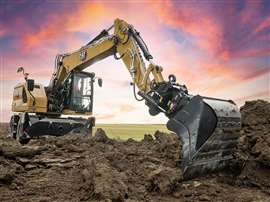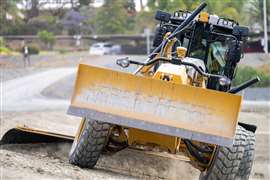Caterpillar: Making the most of on-board operator technology
25 September 2023
Understanding the full capabilities of the assistance features currently sitting within many construction machines could be a key factor in boosting profits, reducing emissions and taking productivity to new levels.
This technology is currently at our disposal, but, as experts from Caterpillar explain, is all too often underutilized.
The company’s tech specialists have been talking about the pain points on jobsites and believe many of today’s biggest challenges – efficiency and productivity, worker shortages, safety and sustainability – could be improved through the increased use of features already built into many machines.
Increasing efficiency
According to heavy construction specialist Gary Martin, one area of growing concern is the lack of experienced operators – a problem that is only going to become more challenging. He says, “As the bulk of skilled operators globally sits within the 45- to 55-year-old bracket and we see a lower influx of new operators coming onboard, this issue will only go in one direction – a skills shortage of people to sit in the seat.”
 Technology adds precision that can benefit even the most experienced operators. Photo: Caterpillar
Technology adds precision that can benefit even the most experienced operators. Photo: Caterpillar
Yet, even for an inexperienced operator, understanding how to make full use of the technology that can be accessed from within the cab should result in increased efficiency and reduced stress levels.
“It’s all about the operator,” says Gary, “and about getting that operator up to speed as fast as you can.
Back in the day, you’d start as a laborer, maybe out on a shovel or helping lower pipe into a trench. You’d really grow yourself into that jobsite and understand a lot of different applications.
Today, it just doesn’t work that way, with the struggle to get operators.”
Gary believes easy-to-use technology, accessed via intuitive touchscreen displays in the cab, hold the key to maintaining high levels of efficiency on the jobsite.
He says, “You’re getting guys and girls that want to work, but they don’t understand grade, or how to get the machine to lay that grade down, so we need technology to take that brand new operator and make them able to spread that material out or grade to within that tenth [of an inch] by the end of the week. We can’t give them three or four years to learn how to do that.”
Gary adds, “Technology built into, for example, a dozer allows novice operators to lower the blade to a predetermined level, from where it pulls the material out and grades it to that pre-designed level.
Apart from the lower skill levels required, operators can grade perfectly without the intense levels of concentration previously required, reducing fatigue levels.
We need that productivity. We need the operators to get that work done.”
The technology boost
The staffing issues we see today in construction stem not only from a lack of experienced workers, but also from a lack of new starters.
The number of young people expected to enter the industry in the next few years is far smaller than the number of experienced construction professionals set to retire.
For this reason, it’s important that workers are used in the most efficient way on jobsites – and that means making the best possible use of technology features.
Gary says these features are “removing the required inputs that an operator has to put into the machine to achieve grade.
“When we look back at the days of all the information that had to be put out on the dirt… that took a lot of time. A lot of time to carry that expertise and to be known as a finished operator.
 More accurate payloads equate to reductions in both cycle times and fuel usage. Photo: Caterpillar
More accurate payloads equate to reductions in both cycle times and fuel usage. Photo: Caterpillar
Now we can get the operator there a lot quicker.”
And he adds an important note about improved safety on site, saying, “Technology helps me build easier, faster, quicker and with more profit, but nonetheless a lot safer, because we can take individuals out of harm’s way, such as grade checkers, and reallocate those resources to other jobs in this growing industry.”
Grading application specialist Thomas Herrera agrees, saying, “If you have a string and tape, you might have to have two people – one to hold each end of the string and maybe someone to measure in the middle of the tape.
We don’t have that luxury anymore, so you take that laser transmitter and you put it on a detector and a grade rod and now you can go and get those elevations all by yourself.”
Giving a specific example of how technology can assist operators, Thomas says, “We really focused on ease-of-use in our Cat Grade technology. For example, our grade control buttons are integrated into the factory joystick controls and the machine has all necessary sensors built-in from the factory for seamless operation.
Along with this, our integrated assist features such as the semi-autonomous digging capability with Cat Grade with Assist on excavators or automatic horizontal steering with Steer Assist on select dozers models help operators get to grade faster and more accurately and allow less experienced operators get up to speed quicker.”
The connected jobsite
The advanced technology that comes as standard with many of today’s construction machines is significant, but is also now an essential element of many segments of the industry. The technology within the machines also integrates into the office – via a range of applications that allow construction fleet owners to understand how efficiently their machines are working.
Construction operations of any size need accurate data to tell them exactly what is going on in terms of production levels, fuel burn and idle time on their jobsites. Viewing this data at an individual machine level, jobsite level and all the way up to the organization level with multiple jobsites running fleets of machines is essential to not only reducing costs but also enhancing safety from the smallest of operations to the largest.
“It’s all about giving the decision maker an accurate picture of their operation and providing them with opportunities to implement change, and make improvements to machine utilization and operational efficiency,” says Michael Miller a Caterpillar Commercial Consultant specializing in productivity.
Operators globally are moving thousands of tonnes/cubic meters of material every day; knowing travel loaded time, travel empty time, load time, dump time, roading time, swing time, dig time as well as how long each machine is waiting are key to making the decisions that have the most impact.
 Easy to use technology can take the strain out of grading. Photo: Caterpillar
Easy to use technology can take the strain out of grading. Photo: Caterpillar
Michael uses the common example of excessive waiting time in the load area. “VisionLink Productivity can track and show the material movement and importantly how much time is spent in each part of the cycle. By slowing the machines down on the return, you could keep a more consistent flow of traffic and potentially reduce the non-productive waiting time and fuel consumption.”
The last word in technology
Product application specialist Ana Pinzon says experienced construction professionals often ask her whether the latest generation of excavators really need the level of built-in technology they have.
In answer, she says, “Using the technology to its fullest, we increase safety and productivity, we load the hauling units to the optimal payload, we’re digging quicker and more accurately and we have fewer people working on the ground.”
With so many challenges facing the construction industry, the benefits of technology that can ease the pressure within many project applications, improve the outcomes for new operators and keep jobsites safe should not be overlooked.





